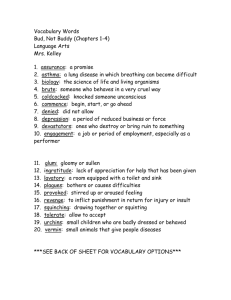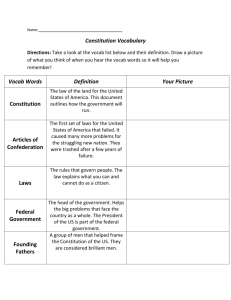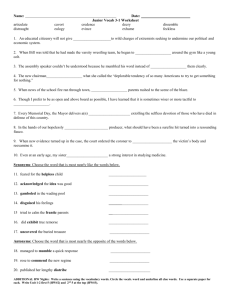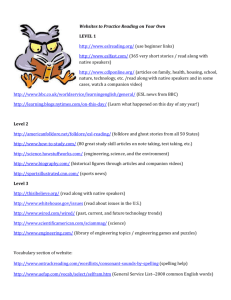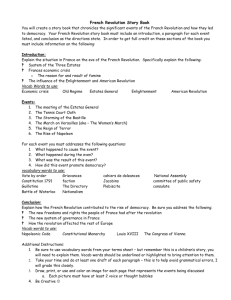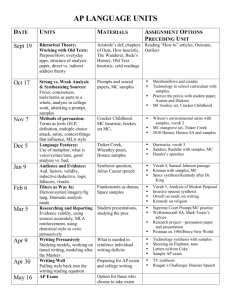Vocabulary
advertisement
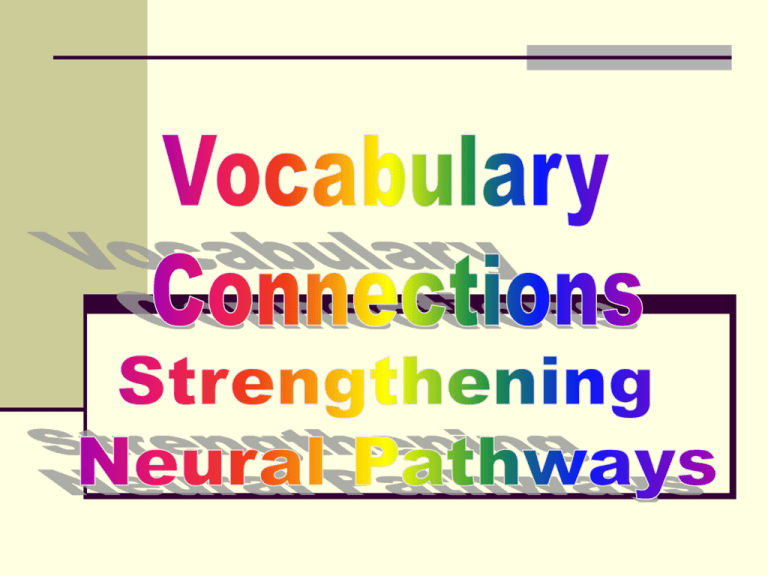
SIOP Workshop Objectives Content Obj: We will practice useful strategies for direct instruction of basic and academic vocabulary for ALL students Language Obj: We will discuss, justify, note, & share vocab activities & applications. Sustaining SIOP #2 Building Background 3 features of building background= linking to Ss; linking to past/ new lrng; & vocabulary past future present Connect to Students’ Lives How do we learn about our Ss’ back-grounds? CO: Brainstorm this topic. LO: Write ideas in your group; share out orally to whole group. Explicit Connections Review previous objectives Remember when we talked about … What did we learn about yesterday in math? Connect to other disciplines (& real life)! Make it relevant to future classes (& life). Who needs instruction in basic vocabulary terms? Marzano (2010): Two types of students in uniquely precarious situations regarding basic vocabulary development: FRL & ELL students Vocabulary development is highly correlated with family income and SES. Widening Gap Differential rate of 1. 2. 3. vocabulary development (low-, mid-, high- SES) Widening gap begins < 24 months 3 categories of ELL: Arrive prepared for school in L1 Not prepared in L1 In US w/ BICS in Eng Categorizing Vocabulary Multiple ways – Marzano > rank ordered 1. 2. 3. clusters or academic disciplines Marzano - Tiers – 1 – 5 (basic to super advanced) What we all MUST teach: Content Words Process/Function Words Words/Word Parts Content Words Key vocab words, terms & concepts associated with the topic being taught. (e.g. Juneteenth, Jim Crow, slavery, Civil Rights, integration, abolition, segregation, under-ground railroad, emancipation) CO:Order these words. LO:Justify your decision. Content Words 1- High Frequency Words – ELLs probably know these in L1 2 – Academic Words – ELLs probably do NOT know these in L1 > TEACH EXPLICITLY! 3- Uncommon – Explain quickly and move on Process/Function Words Functional language: request info, justify opinions, state conclusions Classroom tasks: share with a partner, line up, graph, classify Language processes: scan, skim, question, debate, argue, sum up Transition: therefore, in conclusion, moreover Sequence: first, next, at last, finally Words & Word Parts that Teach English Structure 175,000 words w/roots - Gr. 12 (Biemiller,2004) 15,000 = majority K-6 > 800-1200/year (Dale & O’Rourke, 1981) photo- > compare the words related by spelling and meaning to reinforce (Bear, Invernizzi, Templeton & Johnston, 2004) Words & Word Parts that Teach English Structure Prefixes & Suffixes – Common Root words MS/HS – Academic Word List – 570 word families (www.uefap.com/ vocab) British spellings Why Dictionaries Fail Baumann, Kame’enui, Ash, 2003 – Instruction relying on definition alone = pedagogically useless Not likely to increase comprehension Better Dictionaries Newbury House Dictionary of Amer. English nhd.heinle.com Oxford ESL Dict. Oxford Picture Dictionary for the Content Areas any ESL or picture dictionary Research Synthesis Blachowicz & Fisher (2000) - Students should be ACTIVE in developing understanding of words and ways to use them. Concept Continuum Idea Suitcases Word Sorts Concept Definition Maps Strategies for Independent Learning Concept Continuum glad, joyful, elated, pleased, content, delighted, cheerful, happy freedom, free will, selfdetermination, autonomy, options, independence, liberty, choice, emancipation “It sure beats doing worksheets.” – Tony M. Idea Suitcases Building on students background + game show fun! What’s inside the suitcase??? Strengthen practice & comprehension Assist in semantic generalization Relate the vocabulary to other contexts (& reinforce!!) Idea Suitcases a movie theater a grocery store the playground your backyard a sporting event the beach the mall the kitchen art class a restaurant countries Word Sorts -tion -sion -tation revolution tension representation taxation passion plantation frustration mission participation vision solution nation Word Sorts People Weapons Issues George Washington Thomas Jefferson Thomas Paine muskets taxation rifles self-governance knives Paul Revere bayonets freedom of religion democracy King George cannons right to bear arms Concept Definition Map What is it? > short definition What is it like???? > adjectives What are some examples??? > concrete examples Concept Definition Map Revolution What is it? Overthrow of govt or social system What is it like? Can be violent; often emotional; usually political; may result in changed system of govt. What are some examples? American Revolution; Arab Spring = Tunisia & Egypt, Libya …; “Velvet” Revolution in Czech Republic, Russian Revolution, French Revolution… Research Synthesis Blachowicz & Fisher (2000) Students should personalize learning: Vocab self-selection Mnemonic strategies Personal dictionaries Pictures/drawings Research Synthesis Blachowicz & Fisher (2000) Students should be immersed in words Word walls Personal word study notebooks Compare/contrast words w/same morphemes Word Walls Using pictures on word walls – Is it cheating or teaching? revolution Research Synthesis Blachowicz & Fisher (2000) Students should build on multiple sources of information to learn words through multiple exposure. Connections Hirsch 2003 – Multiple exposures to word + Myriad of contexts > Deeper level of understanding Resources Marzano, Robert J., Teaching Basic & Advanced Vocab Marzano & Pickering, Building Academic Vocab www.uefap.com/vo cab/select (academic word list) www.wordsift.com

